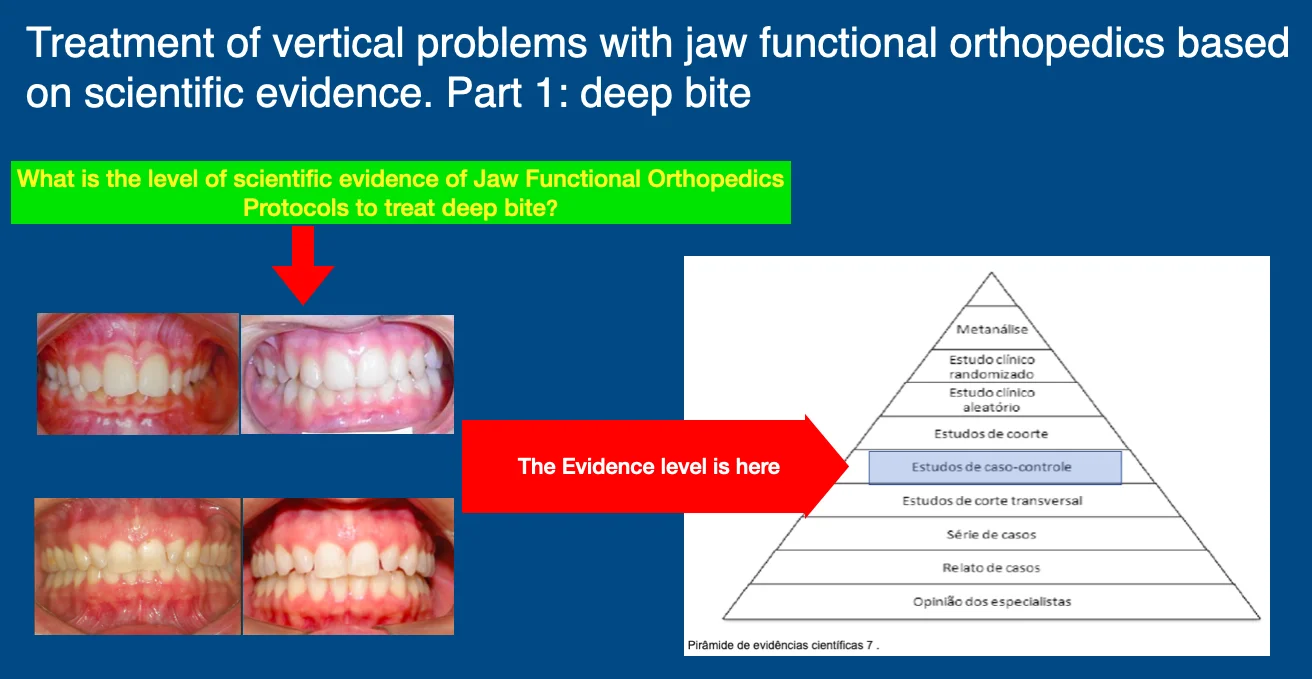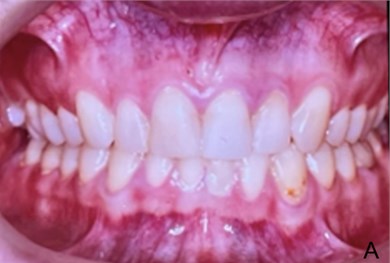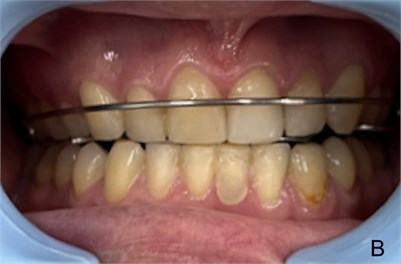Abstract
The vertical problems of the stomatognathic system that alter the overbite, either by increasing in the deep bite (DB) or decreasing in the anterior open bite (AOB), are among the great challenges of the dentofacial corrections in the treatment and the retention and stability protocols. In this paper the state of art of DB treatment with Jaw Functional Orthopedics (JFO) will be discussed. JFO has a unique diagnostic tool for changes in vertical growth of the face, the Articular Compass, developed by Simões. Individuals with hypodivergence and DB are, usually, difficult to treat and more difficult to stabilize the obtained results. Since 1950-decade Planas advocate that the Equiplan – a metal accessory used in functional orthopedic appliances (FOA) is efficient in deep bite treatment by levelling the occlusal plane. Promising results are found with a P = 0,00, but in aweak evidence study design based on the scientific evidence pyramid. Much of the discussion of incisor intrusion or molar extrusion to treat DB seems to be solved with the use of Equiplan, but it still has no scientific evidence, only clinical evidence. In conclusion Randomized Clinical Trials are needed to investigate the efficiency and Modus Operandi of JFO to treat DB.

Highlights
- Jaw Functional Orthopedics showed to be an effective treatment for deep bite.
- Treatment of deep bite with Jaw Functional Orthopedics.
- Deep bite treatment with functional orthopedic appliances has scientific basis but need stronger evidence.
1. Introduction
Deep overbite has been considered as one of the most common malocclusion problems that are difficult to be treated and retained. Correction of the deep bite is often a main objective of the orthodontic treatment because of its potentially detrimental effects on periodontal health, temporomandibular joint function, as well as esthetics [1, 2]. Prevalence of deep overbite was found to be 21 % to 26 % in the normal population [3], and about 75 % in orthodontic patients [4].
One of the biggest mistakes that a beginner in the field of dentofacial correction must committee is dealing with DB as a simple malocclusion. Facial growth pattern is a major data to plan DB treatment. Generally, an individual with short face has a very strong stomatognathic musculature the acts in the posterior teeth with a vector that favors the posterior teeth intrusion, that is to say, favors DB malocclusion, obviously disfavoring treatment [4-6].
Craniofacial structure observed in the cephalogram is a major data in DB treatment planning. The goniac angle measure is fundamental in the decision of using an Equiplan. Based on Bimler cephalometrics, goniac angles below 120°favors the use of Equiplan, above this, the risk of generating an open bite is high and the user o Equiplan is not indicated but the touch of the vestibular incisal third of the crown of the inferior incisors on the palatine incisal third of the crown of the superior incisors, called by Simões as DA (Determined Area), also stimulates vertical growth of the alveolar bone of the posterior teeth [6].
The palatal plane does not influence in the prescription of the Equiplan since it acts in the inferior teeth alveolar bone and after the gain of vertical dimension the posterior superior occlusal plane matures bringing posterior superior teeth to occlusal contact and levels the occlusal plane [6, 7]. So, in deep bite malocclusion the occlusal plane is also a very important factor to be analyzed. A deep bite malocclusion with a profound occlusal plane Spee curve (Fig. 1) has a much better prognosis than a deckbiss occlusal plane with a step between canines and first premolars (Fig. 2).
Fig. 1Occlusal plane with a profound Spee curve. Figure extracted from Simões [6]
![Occlusal plane with a profound Spee curve. Figure extracted from Simões [6]](https://static-01.extrica.com/articles/22779/22779-img1.jpg)
Fig. 2Deckbiss occlusal plane. Figure extracted from Simões [6]
![Deckbiss occlusal plane. Figure extracted from Simões [6]](https://static-01.extrica.com/articles/22779/22779-img2.jpg)
The question a clinician wants to be answered are, in the patient on Fig. 3, the functional orthopedic appliance used will bring any benefits to the individual? Will it bring any side effect to the individual? The objective to this paper is try to give to the clinician those answers.
Fig. 3a) DB can be observed; b) patient with the FOA (in this case a OSS3) with a mandibular posture change stimulating the vertical growth of posterior teeth alveolar bone to correct the DB and mandibular posture change with frontal blocker to correction mandibular deviation


2. Deep bite treatment state of art
Using orthodontics there two basic goals to treat DB, intrusion of anterior teeth and/or extrusion of posterior teeth. Theses orthodontic mechanics are very often associated of mechanical orthopedics. Jung [8] reports the use of mini implants in the vertical control of patients with class II and DB, while Atalla et al. [9] in a systematic review report that the use of mini screws in the anterior teeth intrusion mechanics is clinically validated.
In a search made at “Portal Capes” (periodicos.capes.gov.br) in 06/21/2022 with the keywords “deep bite treatment” AND “dentofacial orthopedics” only three articles are shown. Ghafari et al [10] discuss the benefits and side effects of early and late treatment with orthodontics and mechanical orthopedics. Bahreman [11] that discuss long term stability with early and late orthodontic treatment using removable orthodontic appliances and orthodontics. Nosouhian et al [12] made a literature review on mini imiplants. There is no data about JFO treatment even using dentofacial orthopedics as keyword. Using the same keywords at Medline (ncbi.nlm.nih.gov/pubmed), the search resulted in no articles.
Santiago et al [13] presents a functional orthopedic appliance (FOA) to treat deep bite malocclusion that uses and Equiplan but did not show any statistics about clinical efficiency of the appliance. Santiago [14] reported the use of Planas’ Equiplan fixed on FOA to treat DB malocclusion. Besides very promising results, it has to be carefully analyzed since it is a retrospective study, without a control group, consequently with weak evidence.
There is weak evidence on the past 10 years in the databases searched to support treatment of DB with JFO, Randomized Clinical Trials comparing results of DB treatment with JFO comparing with waiting list patients or individuals that decided not to submit to treatment or comparing with another protocol clinically validated for DB treatment are necessary. On the other hand, based even in the weak evidence by Santiago [14], the Modus Operandi of the FOA to treat DB is still unknown. There are several theories that have been proved over the years, but they are not proved.
References
-
M. M. El Namrawy, F. El Sharaby, and M. Bushnak, “Intrusive arch versus miniscrew-supported intrusion for deep bite correction,” Open Access Macedonian Journal of Medical Sciences, Vol. 7, No. 11, pp. 1841–1846, Jun. 2019, https://doi.org/10.3889/oamjms.2019.332
-
A. A. Gianelly, J. C. Petras, and J. Boffa, “Condylar position and Class and Class II deep-bite, no-overjet malocclusions,” American Journal of Orthodontics and Dentofacial Orthopedics, Vol. 96, No. 5, pp. 428–432, Nov. 1989, https://doi.org/10.1016/0889-5406(89)90328-4
-
E. Bergersen, “A longitudinal study of anterior vertical overbite from eight to twenty years of age,” The Angle Orthodontist, Vol. 58, pp. 237–256, 1988, https://doi.org/10.1043/0003-3219(1988)058<0237:alsoav>2.0.co;2
-
W. Proffit, H. J. Fields, and L. J. Moray, “Prevalence of malocclusion and orthodontic treatment need in the US,” International Journal of Adult Orthodontics and Orthognathic Surgery, Vol. 13, pp. 97–106, 1998.
-
R. E. Moyers, Handbook of Orthodontics. Chicago: Year Book Medical Publishers, 1988.
-
W. A. Simões, Ortopedia Funzionale Dei Mascellari. Attraverso La Riabilitazione Nuero-Occlusale. (in Italian), 2010.
-
P. Planas, Rehabilitación Neuro-Oclusal (RNO). (in Spanish), Barcelona: Masson Salvat Odontologia, 1994.
-
M.-H. Jung, “Vertical control of a Class II deep bite malocclusion with the use of orthodontic mini-implants,” American Journal of Orthodontics and Dentofacial Orthopedics, Vol. 155, No. 2, pp. 264–275, Feb. 2019, https://doi.org/10.1016/j.ajodo.2018.08.016
-
Ahmed Ibrahim Atalla, Mai Hamdy Aboulfotouh, Fady Hussein Fahim, and Manal Yehia Foda, “Effectiveness of orthodontic mini-screw implants in adult deep bite patients during incisor intrusion: a systematic review,” Contemporary Clinical Dentistry, Vol. 10, No. 2, p. 372, 2019, https://doi.org/10.4103/ccd.ccd_618_18
-
J. G. Ghafari, A. T. Macari, and R. V. Haddad, “Deep bite: Treatment options and challenges,” in Seminars in Orthodontics, Vol. 19, No. 4, pp. 253–266, Dec. 2013, https://doi.org/10.1053/j.sodo.2013.07.005
-
A. A. Bahreman, “Retention considerations in the assessment of long-term stability in early versus late orthodontic treatment,” in Seminars in Orthodontics, Vol. 23, No. 2, pp. 123–148, Jun. 2017, https://doi.org/10.1053/j.sodo.2016.12.003
-
Saeid Nosouhian, Mansour Rismanchian, Roya Sabzian, Elham Shadmehr, Hamid Badrian, and Amin Davoudi, “A Mini-review on the Effect of Mini-implants on Contemporary Orthodontic Science,” Journal of International Oral Health: JIOH, Vol. 7, No. Suppl 1, p. 83, 2015.
-
O. Santiago Júnior, M. Vedovello Filho, M. V. Lucas Ferreira, and R. Huebner, “Functional orthopedic appliance for vertical dimension increase and mandibular deprogramming Orlando Santiago System 1 – OSS1. Indications and laboratorial manufacturing,” Jaw Functional Orthopedics and Craniofacial Growth, Vol. 1, No. 1, pp. 12–17, Jun. 2021, https://doi.org/10.21595/jfocg.2021.22079
-
O. Santiago Júnior, “Does Planas’ Equiplan really work in deep bite treatment?,” Jaw Functional Orthopedics and Craniofacial Growth, Vol. 1, No. 2, pp. 75–80, Dec. 2021, https://doi.org/10.21595/jfocg.2021.22329
About this article
The authors have not disclosed any funding.
The datasets generated during and/or analyzed during the current study are available from the corresponding author on reasonable request.
The authors declare that they have no conflict of interest.
The research met all applicable standards for the ethics of experimentation. Permit to perform biomedical investigation was granted by Brazilian Ethic Committee. According to item V of the sole paragraph of resolution No. 510/2016 in its article 1st – “investigation with data base, whose information is aggregated, without the possibility of individual identification”, there is no need for approval of the research by the ethics committee (https://www.propq.ufscar.br/etica/cep/duvidas-frequentes). Participants provided written informed consent prior to the experiment.”
